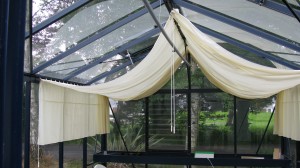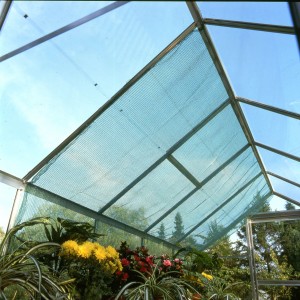In hot sunny weather opening all available doors and vents may not be enough to cool your greenhouse, especially if there’s no breeze. Plants suffer from stress if the temperature goes above 25-27°C (77-81°F): they wilt if they fail to get water from the soil and up to their leaves as fast as it evaporates out. If they wilt badly enough the leaf edges will die and turn brown (scorch) and growth and yield will be reduced.
Apart from plenty of watering and full ventilation, shading is the answer. It blocks the entry of infra-red light into a greenhouse and reduces the build-up of heat but it also reduces the visible light needed for plant growth, so use only as much shading as the plants need and only when they need it. A recording thermometer can help you decide how much and when.
Shading paint can be applied to glasshouses with aluminium or painted wood frames, but it can stain polythene, polycarbonate and unpainted wood permanently. Paint it on in spring or summer when needed and clean it off in autumn when no longer wanted. It’s inflexible when the weather changes often.
Shade netting or roller blinds can be fixed up to the inside of the frame or over the top of the greenhouse, and small plants can be shaded with larger plants or sheets of newspaper or tinfoil above them. Shading fixed inside the greenhouse is easier to adjust and blocks direct sunlight from the plants, but it still allows heat to build up. External shading controls the heat better, but can be more expensive to fit and interfere with vents. Automated blinds are handy but cost more.






